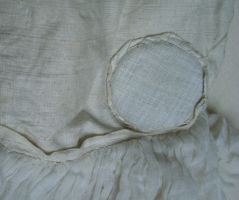| INDEX | 1300-1599 | 1600s | 1700s | 1800s | 1900s | CROSS-ERA | ETHNO | |
| MISCELLANY | CONTACT | SEARCH | |
 There
isn't much left to do. I expect you can do the skirt and sleeve hems by yourself.
There
isn't much left to do. I expect you can do the skirt and sleeve hems by yourself.
The model has one special feature: Each seam had a lead disc sewn in behind the vertical sleeve seam. The discs are 4 cm in diameter and 2mm thick. They sit under an extra piece of lining linen which is whip-stitched onto the sleeve lining.
The batiste ruffles have been whip-gathered, then whip-stitched to linen tape. The tape was then basted to the lower end of the sleeve. It is unusual that the sleeve bears neither cuffs nor ruffles or any other hem decoration. You sometimes find this after ca. 1770, but mostly on round gowns. For a while I had entertained the idea that someone had altered the gown in the 19th century, but then why leave the batiste ruffles in place? I'm pretty sure the ruffles are original: two-layered, hand-rolled, whip-gathered and attached to tape - all techniques typical of the 18th century, very finely done.
I leave it to you to add ruffles, sleeve decoration etc. Just keep in mind that this in an English robe, not a French robe à l'anglaise, so take your inspiration from English 1760s/70s robes rather than Continental ones.
Content, layout and images of this page
and any sub-page of the domains marquise.de, contouche.de, lumieres.de, manteau.de and costumebase.org are copyright (c) 1997-2022 by Alexa Bender. All rights reserved. See Copyright Page. GDPO
This work is licensed under a Creative Commons License.